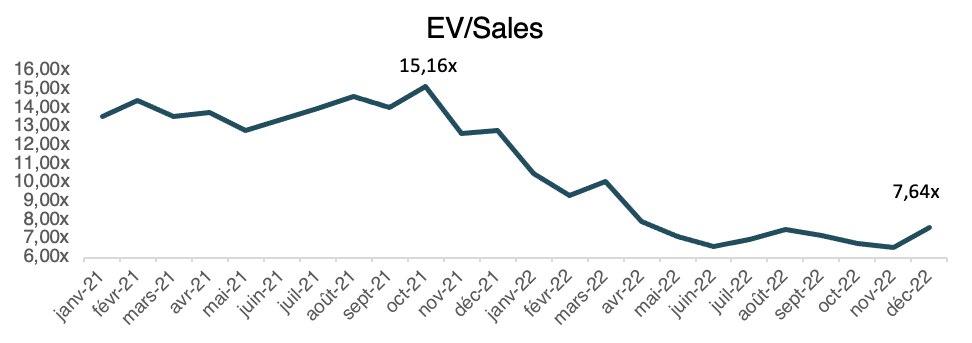SaaS stocks have significantly underperformed in 2022. The E-Spring B2B SaaS Index is no exception, with EV/Sales multiples falling by around 40% over the year.
SaaS Market Overview:
The global market size is estimated at USD 186.6 billion in 2022, growing at a historical annual growth rate of 18%, and is expected to exceed 200 billion by 2023. Furthermore, it is anticipated to have a CAGR of 11% until 2028.1
Regarding the economic landscape, inflation is still reaching an all-time height. In Europe, it reached an average of 9.9% during 2022 (Eurostat,2022) while Belgium experienced a skyrocketing 12.1% (Statista,2022). On the other side of the world, the US experiences its lowest inflation since 2021 at 7.7%. The flight to safety is still an important topic for investors. It is still decreasing in December 2022 when the FED announced inflation reached 7.1%.
According to GP Bullhound’s2 report on the European SaaS market, 2022 has seen the sector evolve quite significantly. First, the intensity of M&A deals in the field was significant as the 2022 deal level was above 2020 and 2019. Next, the report stated that 33% of SaaS companies interviewed were aiming at raising funds in the next twelve months. The fundraising activity of 2022 has been decreasing in Q2 & Q3 of 2022, however, it is still more important than 2021 YTD.
Regarding the total deal value in 2022, we notice a slight decrease of 4.5% compared to 2021. Several factors might explain this reality, notably the increase in interest rates. The increasing costs of money and the drop in valuations are a result of the ECB increase in its key interest rates of 195 bp on average since March 2022 as a policy to limit the inflationary market.
Market trends:
The SaaS industry is facing strong challenges. In fact, the substantial growth the market has undergone has brought up the need to adapt to new standards and create opportunities.
The first one is a significant switch from general to niche SaaS which implies a verticalization movement amongst the SaaS industry. The usual bundle of software is evolving towards micro-SaaS with precise and innovative features dedicated to meeting the needs of a specific niche of customers3.
The second one is the cross–platform. The development of applications was historically focused on computers mainly due to technological limitations. However, recent technology such as smartphone and tablets are capable of handling complex tools and data. This progress has now led to the opportunity for synchronized data between disparate systems. Laptops, tablets, and phones are fully part of business life, and have an increasing market size. Therefore, cross-plateform use needs to be optimized as well. The free access to the service across the platform is therefore an opportunity for the provider that should not be underestimated.4
A challenge directly linked to this specific change is the increasing growth of PaaS (Platform as a Service). Software complexifies itself by adding specific features which increase the resource needed to function properly. In addition, SaaS tends to offer predefine features with little to no customization. PaaS providers developed a cloud-based platform where customization of app is easier and faster than coding it. Then cloud base computing will allow decreasing expenses in hardware to use the different apps.5 Clients will be allowed to purchase add-ons and/or develop the apps that fit their needs the most. It would lead to a more personalized experience thus increasing the retention rate of clients.6
A trend going to heavily influence the industry is the incorporation of AI within the formula. Proper implementation of Ai would create a strong competitive advantage. It creates optimized data treatments and more efficient analyses which allow a better understanding of the client’s needs. Then, Ai and Machine Learning reduce support costs and improve the customers’ experience and customer support.7
Summary:
The E-Spring B2B SaaS index has declined by 40% over the past twelve months. The index reached its lowest level in November, with an EV/Sales of 6,54x, while its highest level was recorded in October 2021, with a ratio of 15,16x. The macroeconomic environment has put a lot of pressure on public SaaS. Inflation and rising interest rates have been the main drivers of this market downturn. The current trend of the SaaS industry is still attractive even though the current market conditions are not the more appropriate. The SaaS model remains very strong due to its recurring nature and its ability to deliver high value to customers with an easy-to-deploy model. The SaaS industry is still forecasted to grow up to 10% in the next four years. However, it will be facing challenges that need to be addressed properly in order to keep continued growth.
E-Spring B2B SaaS index over 24 months

Ins & Outs:
Several companies changed status during Q3 and Q4. Zendesk was acquired by groups of investors led by Hellman & Friedman and Permira. Attraqt Group was acquired by Crownpeak Holdings and Avalara has been bought by Vista Equity Partners. NortonLifeLock Inc. acquired Avast plc. Therefore, the index lost some data providers.
We will readjust the index to 40 companies from the beginning of 2023.
Post written by François Mathieu, Associate.
References:
1. Grandview View Research (2022). SaaS Market Size, Share & Trends Analysis Report By Type (Enterprise Software, Productivity Software), By Region (North America, Europe, APAC, Central & South America, MEA), And Segment Forecasts, 2022 – 2028.
2. GP.Bullhound. European SaaS report (2022).
3. Swifterm. (December, 2022). The essential guide to the SaaS Industry.
4 & 6 & 7. Finance Online. (2022). 11 SaaS Software Trends for 2022/2023: New Forecasts You Should Know.
5. Fyle HQ. (2022). Future of SaaS: 12 Trends to look out for in 2023


